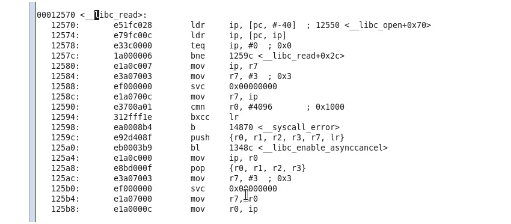驱动原理(应用程序访问驱动程序)
以read为例:
read是一个系统调用,系统调用之前在应用程序当中(或者叫用户空间当中),read的实现代码在内核中,read是如何找到内核的实现代码呢?
/********************************************* *filename:read_mem.c ********************************************/ #include <stdio.h> #include <sys/types.h> #include <sys/stat.h> #include <fcntl.h> int main() { int fd = 0; int dst = 0; fd = open("/dev/memdev0",O_RDWR); read(fd, &dst, sizeof(int)); printf("dst is %d\n",dst); close(fd); return 0; }
这个应用程序就是打开字符设备文件,然后使用系统调用,去读取里头的数据,
用 arm-linux-gcc static –g read_mem.c –o read_mem
反汇编:arm-linux-objdump –D –S read_mem >dump
找到主函数:vim dump -> /main

找到libc_read函数

关注两行代码:
mov r7,#3
svc 0x00000000
read的系统调用在应用程序当中主要做了两项工作,3传给了r7,然后使用svc指令。
svc系统调用指令,系统会从用户空间进入到内核空间,而且入口是固定的,3就是代表read要实现的代码,根据3查表,查出3代表的函数,然后调用这个函数。
打开entry_common.S;找到其中的ENTRY(vector_swi)

在这个函数中得到调用标号

根据标号找到一个调用表

然后找到进入表

打开calls.S文件,会得到一张系统调用列表(部分图示)

3代表的就是read;
分析sys_read,原函数在read_write.c文件中(/linux/kernel code/linux-2.6.39/fs)
SYSCALL_DEFINE3(read, unsigned int, fd, char __user *, buf, size_t, count) { struct file *file; ssize_t ret = -EBADF; int fput_needed; file = fget_light(fd, &fput_needed); if (file) { loff_t pos = file_pos_read(file); ret = vfs_read(file, buf, count, &pos); file_pos_write(file, pos); fput_light(file, fput_needed); } return ret; }
函数fd进去后,利用fd找到文件所对应的struct file,利用struct file调用vfs_read();
ssize_t vfs_read(struct file *file, char __user *buf, size_t count, loff_t *pos) { ssize_t ret; if (!(file->f_mode & FMODE_READ)) return -EBADF; if (!file->f_op || (!file->f_op->read && !file->f_op->aio_read)) return -EINVAL; if (unlikely(!access_ok(VERIFY_WRITE, buf, count))) return -EFAULT; ret = rw_verify_area(READ, file, pos, count); if (ret >= 0) { count = ret; if (file->f_op->read) ret = file->f_op->read(file, buf, count, pos); else ret = do_sync_read(file, buf, count, pos); if (ret > 0) { fsnotify_access(file); add_rchar(current, ret); } inc_syscr(current); } return ret; }


